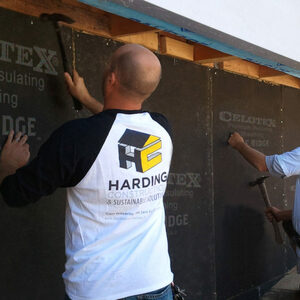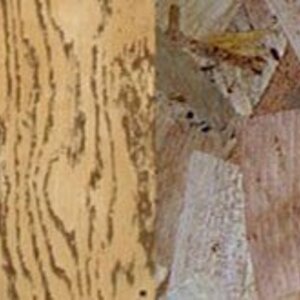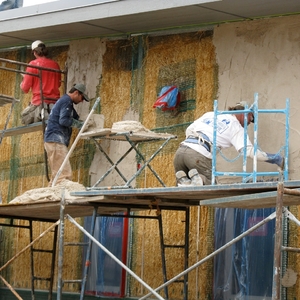
Many builders started using oriented strand board (OSB) in the late 1960s, when it offered a lower-cost alternative to plywood. Its wood-chip composition had environmental appeal; it was touted as a resource-efficient product because it is made with the pulp of fast-growing tree species. Over the years, OSB has almost superseded plywood in structural framing. Although cost remains OSB’s principal advantage, plywood has begun to rebound because it resists moisture better and, from a life cycle perspective, it has a better environmental profile.
OSB vs. plywood
Comparing the two materials, performance characteristics are similar, and for the building codes (except Miami/Dade), OSB and plywood are interchangeable. Plywood is lighter than OSB, weighing about 67 pounds for a 23/32-in. 4×8 sheet, whereas OSB tips the scales at 78 pounds—about 16% heavier. This factors in the transportation impacts of OSB. It takes more fuel to lug a heavier load down the highway. Both plywood and OSB can suffer from exposure to water, but plywood dries more quickly and returns to its nominal thickness, whereas OSB remains permanently swollen—sometimes causing nails to loosen and pull out. While OSB has excellent shear strength for walls, plywood is stiffer and hence preferred by some builders for use on floors. Overall, both materials perform well and remain on par in most applications.
Despite its lower cost and resource efficiency, OSB has a higher overall environmental impact according to a life cycle assessment performed using BEES, the National Institute of Standards and Technology’s, Building for Environmental and Economic Sustainability software. If we limit the comparison to carbon, both materials’ typical median register is just above the 230 kg CO2e per unit, according to the Carbon Leadership Forum (CLF) ratings. However, the comparison tilts toward plywood when considering the full range of environmental effects.
In a study…
Weekly Newsletter
Get building science and energy efficiency advice, plus special offers, in your inbox.

This article is only available to GBA Prime Members
Sign up for a free trial and get instant access to this article as well as GBA’s complete library of premium articles and construction details.
Start Free TrialAlready a member? Log in















12 Comments
Wonderful summary. I insist on plywood for my building projects, has been around since at least the late 1950's in my part of the world.
For the rest of my comment, let me say that I wish most of them weren't true. I'd love to never use osb again, and solely use good quality plywood.
Plywood has always been a curious creature for me. For the praises it generates vs OSB, I've never came across much plywood that has OSB's uniformity. The QC seems to be all over the place in the south east. There's not really an "Advantech" of plywood that holds up as well, or with the guarantees. All the construction community needs is a 15/32 four-ply panel with an integrated WRB @ a 50% premium to commodity OSB and it would be selling like hotcakes.
Even if you could find a good source of comparable stock, it wouldn't matter. That's plywood's largest downfall. It's often 2 - 2.5x as expensive compared to OSB, and for that reason alone its use has fallen out of favor. I see 100:1 houses being built with OSB all over compared to plywood.
If you can buy a wood structural panel that is available, uniform, and meets the specs for the design, you'd need a new head on your shoulders if you went the the more expensive option.
Plywood holds screws marginally better, and is purported to dry faster without shrinkage. I can't say I've really ever seen those be the game changing decision for the choice between them.
You are correct. With OSB's popularity, most mills have devoted themselves to manufacturing and improving the performance of OSB. But some mills have begun to focus on plywood again precisely because of the environmental impacts and consumer preferences for friendlier materials. We should see the "Advantech" of plywood soon.
That sounds great! Do you have any leads on who's going to be making it?
Another option is board sheathing. If you are in a region with small sawmills, you might be able to source it locally. It's of course not going to be air tight, but peel and stick membranes are a good way to overcome that limitation.
Charlie,
Many of us here still use boards for our foundation form work, then re-purpose them as sheathing until they are used up before switching to panel goods - my own house is done that way. I framed with them for decades and hate every part of using them.
It's time consuming to lay the boards out on a 45 for adequate shear, there is a lot of waste, and the joints at studs have to be cut at 45 too. Once they are up there are enough gaps that inevitably one falls where you want backing for nailing the cladding or trim, and over time those gaps grow, and some boards cup making the surface irregular. I'll take plywood over boards every time.
One trick to get around some of that trouble is to use separate bracing instead of diagonal sheathing. Traditionally that's "let-in" bracing, which is at least as much trouble, but on a double stud wall, you can use the extra cavity space for the bracing. But the cupping and warping over time could be a problem and I wonder how the peel-and-stick will hold up long term--I could imagine it ripping when a board really wants to move.
Charlie,
Unfortunately out here in seismic-land it's even touch and go to get approval to use board sheathing diagonally. It's probably much easier elsewhere.
There are many alternatives to wood sheathing for shear, including 1/2-inch drywall if you're not in an extreme seismic or high-velocity wind zone. Start by checking IRC Table R602.10.3(1). You will see the option.
I just wanted to say that this was a great article.
Thank you, I very much appreciate it.
Great article, as usual!! I've learned so much from you over the years.
It's interesting to compare the 2012 study you quote (which appears to have some issues with apples-to-oranges comparisons, more than a few mislabeled graphs, and is based on data from ~2010), with the APA's EPDs written in 2020 (https://apawood-europe.org/sustainability-standards/us-epd-product-transparency-briefs/). OSB is less unfavorable in the more recent EPDs, with plywood assessed as emitting 90.4% of the CO2 as OSB--and that's per cubic meter. OSB is actually less per pound. And if you take standard US sheathing, 7/16" OSB vs 15/16" plywood, the two products end up very close in carbon emissions per panel, due to OSB's thinner panel dimension. If I understood the various reports correctly, in the 2012 paper the main difference was the amount of fossil fuels used to dry OSB in American mills, which may have changed a lot since the studies that paper quotes.
OSB can famously be made out of really tiny trees, which hypothetically reduces pressure to log older mature forests. How that plays out in reality is surely pretty complex.
I agree with Kyle that plywood has been a problematic product from a quality perspective. We've had several sheets more or less fall apart in place, long after installation, we've had to replace full sheets in finished houses to repair them. OSB is less water-resistant if you pour water on it all the time, but plywood can also fail in this situation, there's some sort of magic window of the right amount of leak to get OSB to fail but plywood to not fail, and in all the houses we've torn apart I think I've seen that once. I'm in a forgiving climate though (CZ4, Washington DC).
I'm not sure anyone is in love with OSB as a material but it has been very reliable for us, is usually a bit less expensive, the EPDs show it to be not that different from plywood if I'm reading those right, so we'll see where this goes in future. Thanks for writing this all up and pointing us in the right direction to do more investigating.
Log in or become a member to post a comment.
Sign up Log in